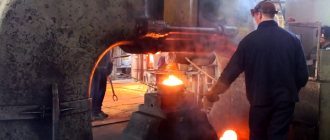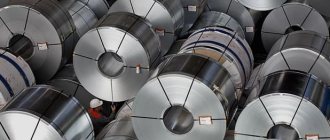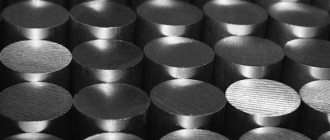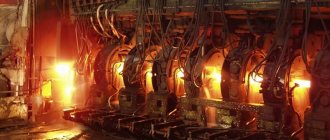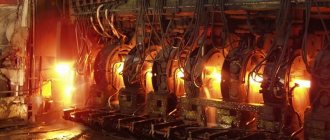ORDINARY QUALITY CARBON STEEL (GOST 380-71*)
Divided into 3 groups
| GROUP | STEEL GRADE | |
| A | St0, St1, St2, StZ, St4, St5, St6 | |
| B | BSt0, BSt1, BSt2, BStZ, BSt4, BSt5 | |
| IN | VSt1, VSt2, VStZ, VSt4, VSt5 | |
According to SNiP II-23-81, only group B steels with grade number 3 are used for welding structures
| BRAND | % carbon | Tensile strength, MPa |
| VSt3kp | 0,14-0,22 | 360 — 460 |
| VSt3ps | 370 — 480 | |
| VSt3sp | 380 — 500 | |
| VSt3Gps | 370 — 490 | |
| VSt3Gsp | 390 — 570 | |
| kp - boiling, ps - semi-calm, sp - calm, G - with manganese content up to 1% | ||
Smelting method
According to the smelting method, steel can be:
- Martenovskaya . It is characterized by low porosity and low content of harmful impurities.
- Converter (Bessemer and Thomas). Thomas steel is characterized by low impact strength at normal temperatures. It is not used for building structures. Bessemer steel is more porous than open hearth steel.
According to the method of steel deoxidation there are:
- Calm.
- Boiling.
- Semi-calm.
Boiling open hearth steel contains more gases than calm steel; it has a less homogeneous structure. Bessemer steel is not inferior in strength to open hearth steel, but the latter is less susceptible to aging and brittleness.
QUALITY CONSTRUCTION CARBON STEEL (GOST 1050-74)
Indicated by a number corresponding to the % carbon content in hundredths
| BRAND | % CARBON | Tensile strength, MPa |
| 05kp | No more than 0.06 | 320 |
| 08kp,08 | 0,05-0,12 | 330 |
| 10kp, 10 | 0,07-0,14 | 340 |
| 15kp, 15 | 0,12-0,19 | 380 |
| 20kp, 20 | 0,17-0,24 | 420 |
| 25 | 0,22 — 0,30 | 460 |
| 30 | 0,27-0,35 | 470 |
| 35 | 0,32 — 0,40 | 530 |
| 40 | 0,37 — 0,45 | 570 |
| 45 | 0,42 — 0,50 | 600 |
| 15G | 0,12-0,19 | 410 |
| 20G | 0,17-0,24 | 430 |
| 25G | 0,22 — 0,30 | 460 |
| 30G | 0,27 — 0,35 | 540 |
| 35G | 0,32 — 0,40 | 600 — 720 |
| 40G | 0,37 — 0,45 | 790 — 820 |
| 45G | 0,42 — 0,50 | 780-1310 |
LETTER DESIGNATIONS
chemical elements used as alloying additives
How to choose a steel grade and what to pay attention to?
In many ways, the mechanical properties of steel depend on alloying additives - vanadium, cobalt, tungsten. Even with minimal contents, they significantly increase the quality of blades.
Therefore, the first thing you should pay attention to is the composition:
- carbon - increases the hardness and strength of steel, increases the blade’s resistance to wear and the appearance of chips and cracks, but a large amount in the composition significantly reduces the overall corrosion resistance;
- chromium – increases the hardness and density of blades, is responsible for resistance to corrosion and the ability to polish the blade. Contained in all modern stainless steels. In addition, the chromium content gives the blades a characteristic polishing shine, adding to their aesthetic component;
- manganese - increases the toughness and hardenability of steel, increases resistance to lateral deformation, but its high content in steel makes it brittle. Steels with a high manganese content are mainly used to make rails and safes; manganese steel is rarely used in the production of knives;
- Molybdenum is an alloying element that gives the metal elasticity and density, improves hardenability and strength. This is a hard-melting element that prevents the blade from becoming brittle, increases resistance to high temperatures, and gives the blade the necessary rigidity;
- vanadium is another alloying element that increases the viscosity and strength of the blade, improves wear resistance, and promotes better calcination. Mainly used for tool steels, in particular surgical steels. Makes the metal inert to aggressive chemicals;
- nickel – prevents rust and acidification of the blade;
- silicon – increases the wear resistance of the alloy, making it more reliable and stable;
- phosphorus - its content in steel is undesirable; it makes the metal brittle, while increasing its strength. The maximum phosphorus content should not exceed 0.045%;
- sulfur is another “harmful” element that reduces resistance to lateral deformation, but increases the strength of the metal when exposed along the axis of the metal grid. High sulfur content significantly reduces the mechanical and physical-chemical properties of steel alloys: ductility, impact strength, anti-corrosion resistance. The sulfur content in good steel should not exceed 0.06%.
You also need to pay attention to the following parameters:
- corrosion resistance - if the knife often comes into contact with water, blood or other liquids, anti-corrosion qualities are leading when choosing a good knife. Any liquid, especially blood, has a bad effect on the overall quality of the material, reduces its resistance to pitting corrosion, and deteriorates the cutting edge when it dries;
- ability to hold an edge - factory sharpening is maintained exactly until the first use, but the working phase directly depends on the composition and properties of the steel. Knives will have to be sharpened in any case, but blades made of high-quality steel retain the sharpness of the cutting edge longer and are less demanding on abrasive materials for sharpening;
- hardness - the harder the steel, the better it can withstand external loads, but soft metal is easier to sharpen. At the same time, soft blades become dull much faster;
- wear resistance - no knife will last forever, no matter how good the steel is, but certain additives in the alloy prolong the life of blades by increasing strength or resistance to chipping, lateral pressure, and deformation.
LOW-ALLOY STRUCTURAL STEEL (GOST 19282-73)
ALLOYED STEEL HAS ALPHANUMERIC DESIGNATION
The first two digits indicate the carbon content in hundredths of a percent. The numbers after the letters indicate the content of the alloying element in%. The absence of a number after the letter indicates that the element contains about 1%
| BRAND | %WITH | %Si | %Mn | %Cr | %Ni | %Cu | Tensile strength, MPa |
| 09G2 | 0,12 | 0,37 | 1,8 | 0,3 | 0,3 | 0,3 | 440 |
| 09G2S | 0,12 | 0,7 | 1,7 | 0,3 | 0,3 | 0,3 | 496 |
| 14G2 | 0,12-0,18 | 0,37 | 1,6 | 0,3 | 0,3 | 0,3 | 460 |
| 10G2S | 0,12 | 1,1 | 1,65 | 0,3 | 0,3 | 0,3 | 490 |
| 15HSND | 0,12-0,18 | 0,7 | 0,7 | 0,9 | 0,6 | 0,4 | 490-687 |
| 10HSND | 0,12 | 1,1 | 0,8 | 0,9 | 0,8 | 0,6 | 530-687 |
| 17GS | 0,14-0,20 | 0,6 | 1,4 | 0,3 | 0,3 | 0,3 | 510 |
| 17G1S | 0,15-0,20 | 0,6 | 1,6 | 0,3 | 0,3 | 0,3 | 510 |
| 17G1S-U | 0,15-0,20 | 0,6 | 1,55 | 0,3 | 0,3 | 0,3 | 510-628 |
Steel marking system in Sweden
In Sweden, steels are marked according to the SS standard using a four-digit number. The first two digits of the indicated number determine the group to which the steel belongs (see Table 6), the last two – the serial number of the steel in the group. The markings distinguish between carbon steels (the first digit of the name) and alloy steels (beginning with the number 2).
Table 6 . Steel marking in Sweden
| Brand | Steel group |
| 12XX – 18XX | Carbon steels |
| 19XX | Automatic steels |
| 20XX | Alloyed Si |
| 1XX | Alloyed Mn |
| 22XX | Alloyed Cr <10% |
| 23XX | Alloyed Cr≥10% |
| 25XX | Alloyed Ni |
| 26XX | High strength weldable steels |
| 7XX | Alloyed W |
| 29XX | Alloyed rest |
Here are some examples:
- 1265 – high-quality carbon steel, in composition, properties and purpose it is close to Russian steels 08 and 10 ;
- 1957 – automatic steel, analogue – Russian steel A35 ;
- 2085 – steel alloyed with silicon, Russian equivalent – 55С2 ;
- 2234 – alloy steel, Cr content <10%, corresponds to Russian steel 30ХМ ;
- 2352 – stainless steel, alloyed with Cr≥10%, Russian equivalent – 03Х18Н11 .
HIGH-ALLOY STEEL AND ALLOYS (GOST 5632-72)
| CORROSION-RESISTANT are resistant to various types of corrosion | |
| BRAND | Tensile strength, MPa |
| 12Х18Н9 | 530 |
| 12X18N9T | 530 |
| 17Х18Н9 | 588 |
| 08X22H6T | 588 |
| 20X2GH14C2 | 630 |
| HEAT-RESISTANT surfaces resistant to chemical destruction in gas environments at t>550°C. Operates in an unloaded or lightly loaded state | |
| 12MH | 420 |
| 12X1M.D | 480 |
| 25X1MF | 900 |
| 25Х2М1Ф | 800 |
| 25ХЗМВФ | 900 |
| HEAT-RESISTANT work in an unloaded or lightly loaded state at high temperatures for a certain time. Sufficiently heat resistant | |
| 08X15M24V4TR | 880 |
| ХН70У | 880 |
| ХН35ВТУ | 930 |
| ХН70ВМУТ | 980 |
| ХН77TYUR | 1080 |
Steel marking systems in the USA
The United States uses several systems for naming metals and alloys, associated with existing standards organizations. The most famous organizations are:
- AISI – American Iron and Steel Institute;
- ACI – American Casting Institute;
- ANSI – American National Standards Institute;
- AMS – Aerospace Materials Specification;
- ASME – American Society of Mechanical Engineers;
- ASTM – American Society for Testing and Materials;
- AWS – American Welding Society;
- SAE – Society of Automotive Engineers.
The notation systems used by an organization are derived from their historical development as well as the development of related industries. Let's look at the most popular steel designation systems used in the USA.
Universal notation system UNS
UNS is a universal designation system for metals and alloys. It was created in 1975 to unify the various notation systems used in the United States. According to UNS, steel designations consist of a letter defining the steel group (Table 9) and five numbers.
Table 9 . Designations of steels in the UNS system
| Symbol | Steel group |
| Dxxxxx | Steels with prescribed mechanical properties |
| Gxxxxxx | Carbon and alloy steels AISI (excluding tool steels) |
| Hxxxxx | The same, but for hardenable steels |
| Jxxxxx | Foundry steels |
| Kxxxxx | Steels not included in the AISI |
| Sxxxxxx | Heat-resistant and corrosion-resistant steels |
| Txxxxx | Tool steels |
| Wxxxxx | Welding materials |
The UNS system makes it easier to classify AISI steels. For structural and alloy steels included in group G , the first four digits of the name are the steel designation in the AISI system, the last digit replaces the letters that appear in the AISI designations. So the letters B and L , meaning that the steel is alloyed with boron or lead, correspond to the numbers 1 and 4 , and the letter E , meaning that the steel was smelted in an electric furnace, corresponds to the number 6 .
The names of corrosion-resistant AISI steels begin with the letter S and include the AISI steel designation (the first three digits) and two additional digits corresponding to additional letters in the AISI designation (see Table 10).
Let's give examples. 1045 carbon steel is designated UNS G 10450 , and 4032 is UNS G 40320 . 51B60 steel is called UNS G 51601 , and the lead alloyed 15L48 G 15484 . Corrosion-resistant steels are designated: 304 - S 30400 , 304 L - S 30401 , 304 H - S 30409 , and 304 Cu - S 30430 .
ASTM designation system
The designation of steels in the ASTM system includes:
- letter A , meaning that we are talking about ferrous metal;
- serial number of the ASTM regulatory document (standard);
- the actual designation of the steel grade.
Typically, ASTM standards adopt the American system of notation for physical quantities. In the same case, if the standard contains a metric notation system, the letter M .
ASTM standards, as a rule, define not only the chemical composition of steel, but also a complete list of requirements for metal products. To designate the actual steel grades and determine their chemical composition, both ASTM’s own designation system can be used (in this case, the chemical composition of steels and their markings are determined directly in the standard), as well as other designation systems, for example AISI - for rods, wire, workpieces and etc., or ACI – for castings made of corrosion-resistant steels.
Let's give examples: In steel A 516 / A 516M - 90 Grade 70, the letter A indicates that we are talking about ferrous metal; 516 is the serial number of the ASTM standard ( 516M is the same standard, but in the metric notation system); 90 – year of publication of the standard; Grade 70 – steel grade. In this case, ASTM's own steel designation system is used, here 70 defines the minimum tensile strength of steel (in ksi, which is about 483 N/mm2). Steel A 276 Type 304 L – this standard uses the steel grade designation in the AISI system – 304 L.
Steel A 351 Grade CF8M. The ACI designation system is used here: the first letter C means that the steel belongs to the group of corrosion-resistant, 8 - determines the average carbon content in it (0.08%), M - means that molybdenum has been added to the steel.
Become
- A 335 / A 335M grade P22;
- A 213 / A 213M grade T22;
- A 336 / A 336M class F22
— in these examples, ASTM’s own steel markings are used. The first letters indicate that the steel is intended for the production of pipes ( P or T ) or forgings ( F ).
Steel A 269 grade TP304 – a combined designation system is used here. The letters TP indicate that the steel is intended for the production of pipes, 304 is the designation of steel in the AISI system.

